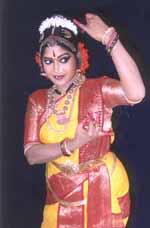Kalarajyam’s Anniversary Celebrations – Myriad Shades of an Artist

Kalarajyam’s Anniversary Celebrations – Myriad Shades of an Artist is an event that took place on 08-Dec-2000 in Hyderabad.
-
Venue
-
Date/Time
-
Type
-
Price
-
Add New Field:
'Kalarajyam' literally means the kingdom of arts. And there was all the opulence associated with the word on display. Just what Kalarajyam would have hoped for on its 28th anniversary. After Prema Ramamurthy's exhilarating performance on the first day, nothing short of absolute excellence was expected from Alekhya. And she showed why she deserved the title of "Nritya Bharathi" that was conferred on her.
It was wonderful to see Swathy Somanath honoring the artist and bestowing upon her the title with words of appreciation. That seemed to have brought out the very best in her. The delightful mood was apparent straightaway, as she commenced with a Nata Ganesha Stuti composed by Mayura Vishvanath Iyer, "Sri Maha Ganapathe".
This benevolent beginning gave way to yet another dance of devotion - "Panchashat Peetha Roopini." This intense composition of Dikshitar, set to a divine Devagandhari Raga, saw the dancer depicting the subtle and celestial grace of Goddess Meenakshi, who, in all her vibrancy and clad in shimmering trinkets, is wedded to the ascetic Siva, adorned with snakes and smeared with ashes.
From this graceful dance of devotion and romance, Alekhya donned the role of an enraged Lord Narasimha ripping out of a giant pillar to slaughter the villain, Hiranyakashipa. "Kadari Narasimhudu", a composition of Annamacharya, depicts this 'Ugravatara' - the fuming form of Lord Vishnu - who looks terrific in this half-lion-half-human incarnation.
Alekhya riveted the audience' attention even as she shifted the mood to one of romance and mystification. In "Evade Vadu" (a padam of Parthasarathi), the heroine is inquisitive about a handsome man who is often seen in a reflective mood hovering around her house, as though in pangs of separation from his beloved. "Who could he be, for, once, he even caught my hand in the dark and pleaded for love. Is he in love with me?" As the heroine asks her confidante, she goes into a trance, only to realize that the man is none other than Lord Vishnu.
This composition creates this concept of 'Madhura Bhakthi' - the relationship of the divine and the mortal. After this expressive dance, Alekhya concluded the performance with a swift and speedy dance representing the dance of Siva - "Shankara Sri Giri Nada Prabha" - in Hamsa Nandi Raaga. The one thing that was great about this performance was the range covered by the artist, without ever disconcerting the viewer.
Vocalist Sweta, percussionist Vinod Kumar, and violinist Subbalaksmi supported the artist.
Be the first to comment on Kalarajyam’s Anniversary Celebrations – Myriad Shades of an Artist! Just use the simple form below.
LEAVE A COMMENT
fullhyd.com has 700,000+ monthly visits. Tell Hyderabad what you feel about Kalarajyam’s Anniversary Celebrations – Myriad Shades of an Artist!
MORE EVENTS IN THIS PERIOD
ALL EVENT CATEGORIES
SEARCH EVENTS
Dissatisfied with the results? Report a problem or error, or add a listing.
ADVERTISEMENT
SHOUTBOX!
{{ todo.summary }}... expand »
{{ todo.text }}
« collapse
First | Prev |
1 2 3
{{current_page-1}} {{current_page}} {{current_page+1}}
{{last_page-2}} {{last_page-1}} {{last_page}}
| Next | Last
{{todos[0].name}}
{{todos[0].text}}
ADVERTISEMENT
This page was tagged for
Sri Thyagaraja Gana Sabha events
December 2000 events
hyderabad arts
hyderabad theatre / comedy / dance